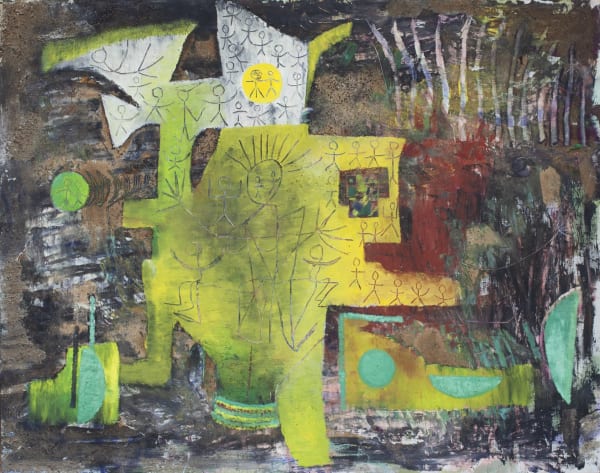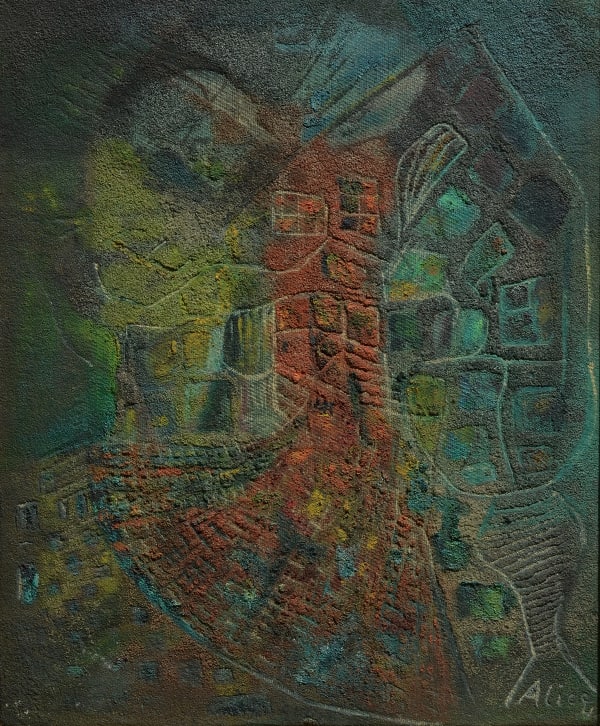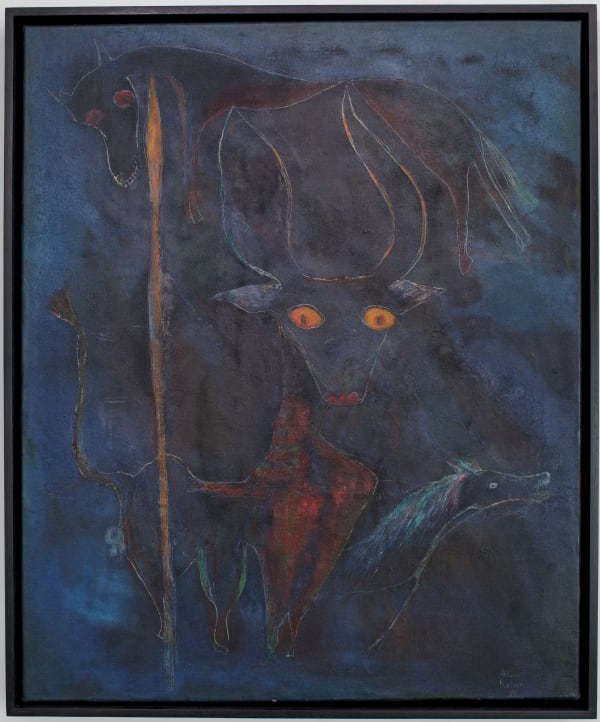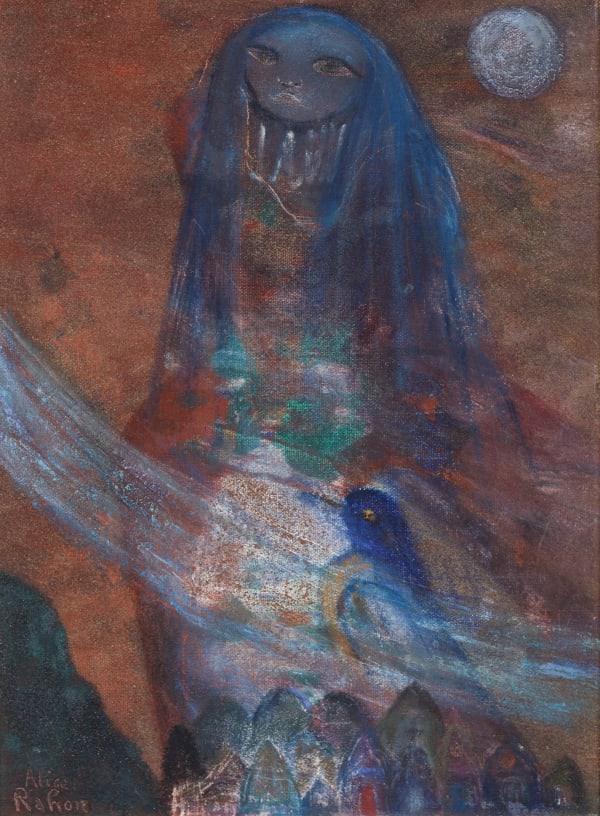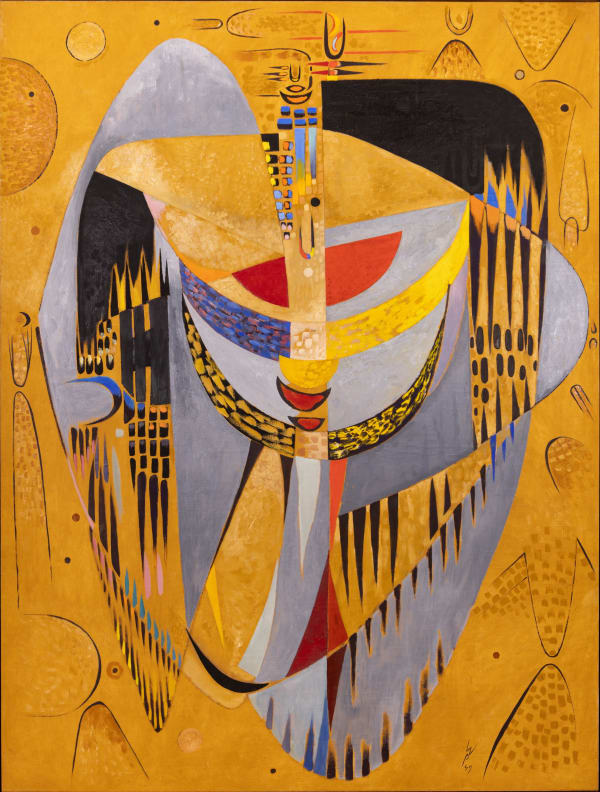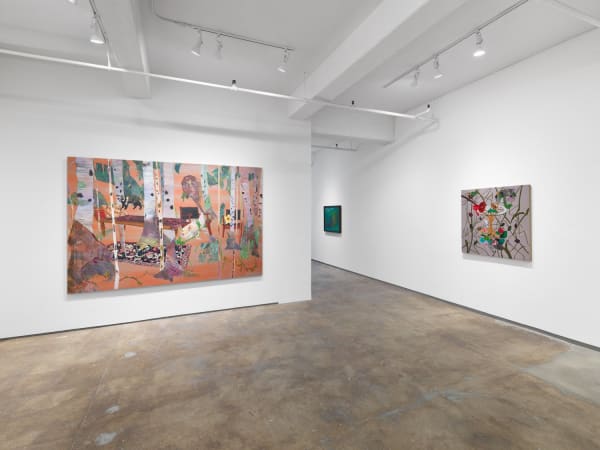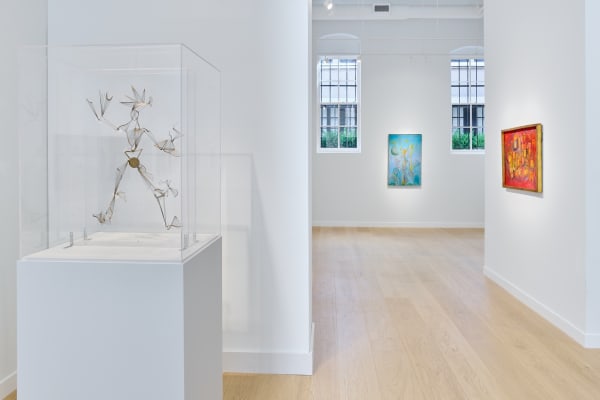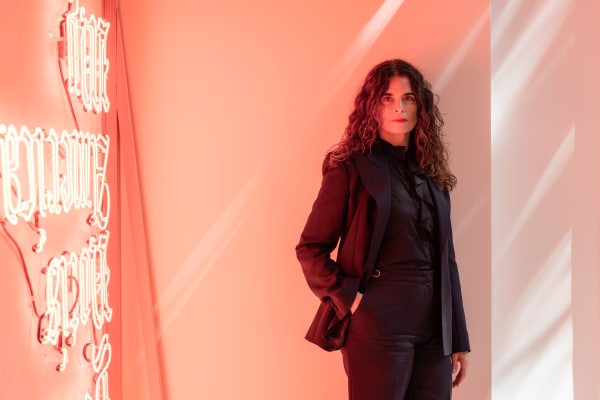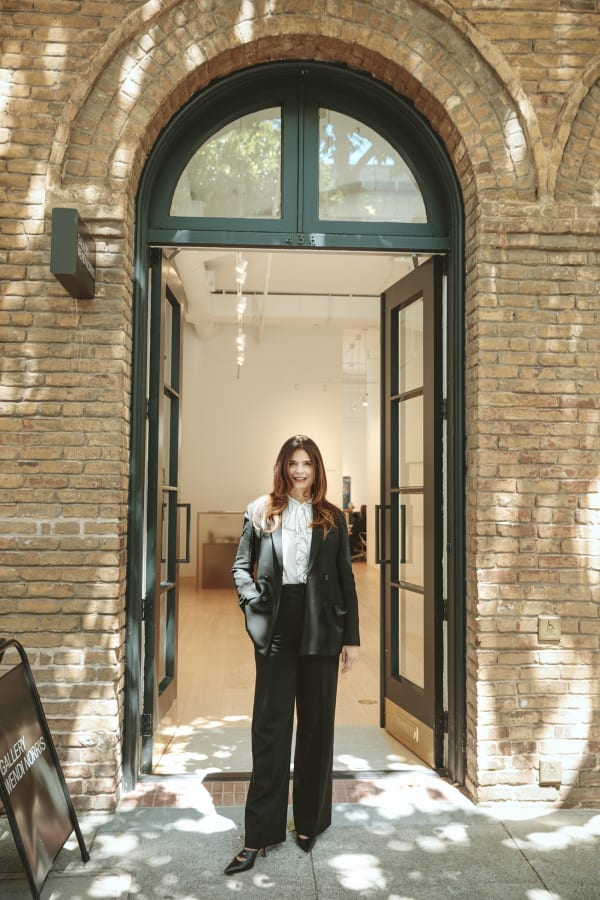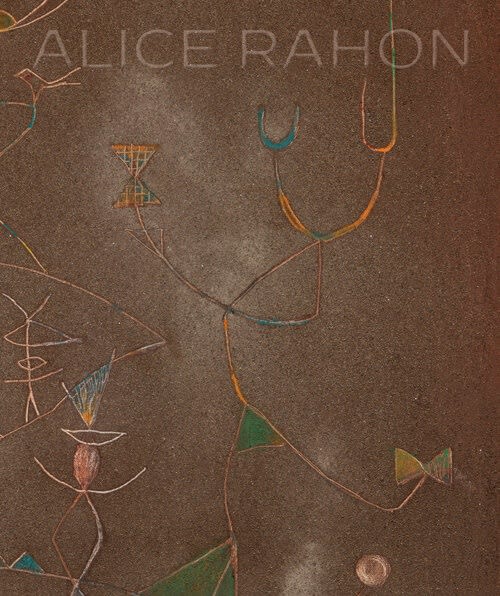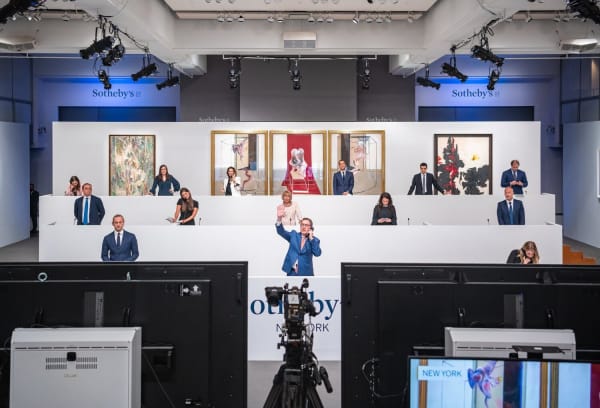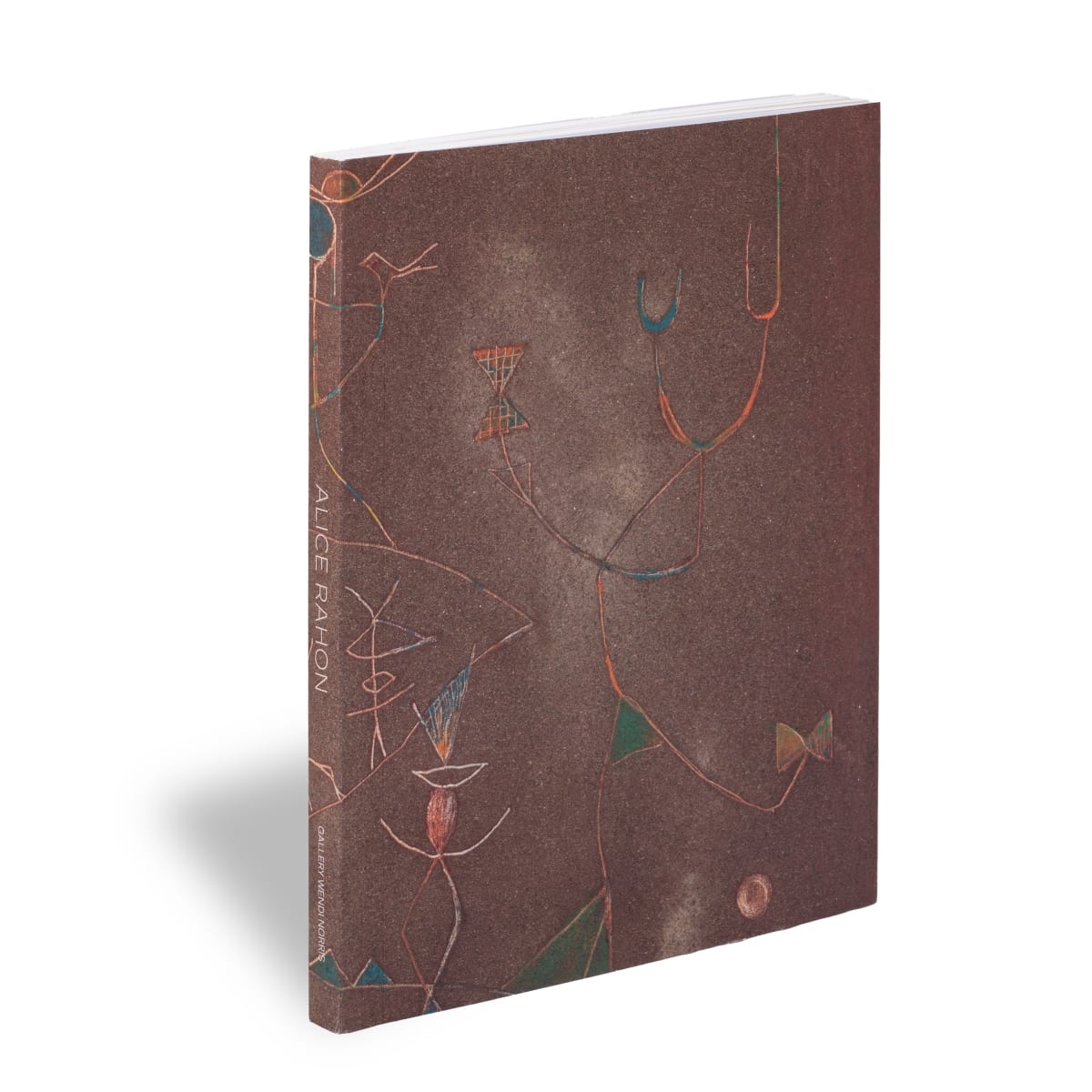Alice Rahon (née Alice Marie Yvonne Philippot) was born in Chenecey-Buillon, France, on June 8, 1904. After publishing three volumes of poetry, she turned to the visual arts at the age of 36 and spent her mature years working almost exclusively as a painter. Rahon died in Mexico City in 1987, a naturalized citizen of Mexico.
The visual vocabulary Rahon created over the course of her career as a painter can be seen as a fulfillment (rather than an abandonment) of her early commitment to language. Like her poetry, Rahon's paintings are thick with mythology and magic, memory and meaning. Compelled as deeply by prehistoric cave paintings as by the Surrealist milieu in which she lived and worked, Rahon wove symbols, colors, and textures together in delicate combinations of figuration and abstraction. Modern analogs to the petroglyphs that inspired them, Rahon's paintings are expressions of an artistic sensibility that reaches from the blank canvas of the present into the cavernous recesses of prehistory.
Little is known of Rahon's childhood, but a brief account of her early years reveals an independent and charismatic young woman of prodigious talent. At some point during her twenties she moved to Paris, where she created hats for the Surrealist-influenced fashion designer Elsa Schiaparelli. She was introduced to Man Ray, for whom she modeled, and became friends with Joan Miró. In 1931 she met the Austrian painter Wolfgang Paalen (1905-1959), who brought her into the circle of Surrealists led by André Breton. She and Paalen were married in 1934.
Writing poetry under her married name, Alice Paalen, she spent the 1930s amongst the Parisian Surrealists and associated artists. In 1936, Breton arranged for the publication of her first book, À même la terre (On the Bare Ground), with an engraving by Yves Tanguy. A second collection of poetry, Sablier couché (Hourglass Lying Down), appeared in 1938 with an etching by Miró. Her third and final volume of poetry was published in 1941 as Noir animal (Animal Black), with a portrait of her by Paalen. Hearing of her nascent interest in prehistoric art, Miró had suggested in 1933 that she and Paalen visit Altamira, Spain. Her encounter with the polychromatic cave paintings of Altamira would prove formative to Rahon's later development as a visual artist.
A second encounter was equally transformative. In 1939, Rahon met Frida Kahlo in Paris, who invited her to Mexico. With the threat of war on the horizon, she and Paalen departed with Swiss photographer Eva Sulzer to British Columbia and made their way south through Alaska and down the Pacific coast to Mexico City, where they would ultimately settle. The indigenous art she studied on that trip, along with her previous exposure to prehistoric imagery, informed her interest in visual art. After 1941 and with the appearance of her final volume of verse, she would dedicate herself almost exclusively to painting.
In Mexico City, under Paalen's tutelage and in the company of émigré Surrealists such as Leonora Carrington and Remedios Varo, Rahon began to paint. One can see the influences of her friends Paul Klee and Miró in her early work, but her deepest inspirations arise from the anonymous artists of Altamira and the indigenous artists of the Americas. Utilizing various media (ink, gouache, crayons, sand, pulverized volcanic rock, iron wire) and found objects (feathers, leaves, butterfly wings), Rahon created images rooted in landscapes, redolent of timelines, and abundant with magic and ritual. She made a practice of sgraffito, scratching through the surface of her paintings to reveal a lower layer of contrasting color. The result is in Rahon's case an iconography that is at once universal and personal, mysterious and immediate, abundant with stories and secrets. Crafted in the tradition of the Surrealists by whom she was surrounded, inspired and influenced by the art of the indigenous people of the Americas, Rahon's work is simultaneously a provocation and a direct, unmediated experience of the marvelous and the astonishing.
Once she started painting, Rahon was recognized almost immediately as an accomplished artist. The San Francisco Museum of Art (now the San Francisco Museum of Modern Art) presented the first of two solo museum exhibitions of her work in 1945. Over the course of her lifetime, Rahon would create roughly 750 works of art and go on to exhibit widely in the United States and Mexico, as well as in Paris and Lebanon. She exhibited regularly with prominent galleries that included Peggy Guggenheim's Art of This Century in New York, Caresse Crosby in Washington, D.C., Stendhal and Copley Galleries in Los Angeles, and Galería de Arte Mexicano in Mexico City. Rahon's work is currently in the collections of the Art Institute of Chicago; the Museum of Modern Art, New York; the Detroit Institute of Arts; the Los Angeles County Museum of Art; the Philadelphia Museum of Art; the Museo de Arte Moderno, Mexico City; the Kemper Art Museum in St. Louis; the Blanton Museum of Art in Austin; and the Davis Museum at Wellesley College, MA, among others. The Museo del Palacio de Bellas Artes in Mexico City presented a solo Rahon show in 1986.
There has been a resurgence of interest in Rahon's visual and written work over the last decade, catalyzed by the Los Angeles County Museum of Art's 2012 show In Wonderland: The Surrealist Adventures of Women Artists in Mexico and the United States. In 2022 her artwork was featured in The Milk of Dreams, Venice Biennale, 59th International Art Exhibition. The Museo de Arte Moderno in Mexico City presented a retrospective of Rahon's work in 2009. A subset of that exhibition was on view at the Museum of Contemporary Art in North Miami in 2019-2020, her first solo museum exhibition in the United States since 1953. Her work has also been featured in various museum exhibitions of Surrealism and Mexican modernism, including Surrealism Beyond Borders at the Metropolitan Museum of Art, New York, and Tate Modern, London (2021-2022); Fantastic Women at the Schirn Kunsthalle, Frankfurt, and the Louisiana Museum of Modern Art, Humlebaek (2020); Modern Couples at the Centre Pompidou-Metz (2018); México 1900-1950: Diego Rivera, Frida Kahlo, José Clemente Orozco y las vanguardias at the Grand Palais, Paris, and the Dallas Museum of Art, TX (2017); Paint the Revolution: Mexican Modernism 1910-1950 at the Philadelphia Museum of Art, PA, Museo del Palacio de Bellas Artes, Mexico City, and Museum of Fine Arts, Houston, TX (2016-2017); Frida Kahlo: Conexões entre mulheres surrealistas no México, at the Instituto Tomie Ohtake, São Paulo, the Caixa Cultural Rio de Janeiro, and the Caixa Cultural de Brasília (2015); and Farewell to Surrealism: The DYN Circle in Mexico at the Getty Research Institute, Los Angeles, CA (2012-2013).
In 2012, Aubé Breton Elléouët, the daughter of André Breton, produced a documentary on Alice Rahon's life and work entitled Alice Rahon, l'abeille noire (Alice Rahon: The Black Bee).
In 2021, The Getty Research Institute acquired the Alice Rahon archive in its entirety. That same year, NYRB Poets released a comprehensive collection of Rahon's poetry, translated by Mary Ann Caws, that includes newly discovered letters and poems from Picasso, Breton, and Paalen, among others.
-
 Untitled
Untitled -
 Mozart (from the Crystals in Space series)
Mozart (from the Crystals in Space series) -
 La cuadra
La cuadra -
 Mémoire de l'eau
Mémoire de l'eau -
 Peau de soleil no. 1
Peau de soleil no. 1 -
 Acapulco de noche (from the Crystals in Space series)
Acapulco de noche (from the Crystals in Space series) -
 Fiesta de Abril
Fiesta de Abril -
 La femme qui neige
La femme qui neige -
 Untitled (from the Crystals in Space series)
Untitled (from the Crystals in Space series) -
 Thunderbird
Thunderbird -
 Juggler
Juggler -
 Androgyne
Androgyne -
 Installation view, "Uncovering Alice Rahon," Gallery Wendi Norris, San Francisco, CA
Installation view, "Uncovering Alice Rahon," Gallery Wendi Norris, San Francisco, CA -
 Installation view, "Alice Rahon And Ranu Mukherjee: Time Warriors," Gallery Wendi Norris OFFSITE, New York, NY
Installation view, "Alice Rahon And Ranu Mukherjee: Time Warriors," Gallery Wendi Norris OFFSITE, New York, NY -
 Painting for a Little Ghost Who Couldn't Learn to Read
Painting for a Little Ghost Who Couldn't Learn to Read -
 Un día alegre
Un día alegre -
 Un puerto del norte
Un puerto del norte -
 Autorretrato con autobiografía
Autorretrato con autobiografía -
 Les chateaux de la nuit
Les chateaux de la nuit -
 ¡Torito, Toro!
¡Torito, Toro! -
 Su majestad y la luna o Luna llena y gata blanca
Su majestad y la luna o Luna llena y gata blanca -
 Los guardianes (La chouette et le rossignol)
Los guardianes (La chouette et le rossignol) -
 Byblos
Byblos -
 Maternidad
Maternidad -
 La noche de Tepoztlán
La noche de Tepoztlán -
 El tucán y el arcoíris, Homenaje a Wolfgang Paalen
El tucán y el arcoíris, Homenaje a Wolfgang Paalen -
 Una gigante llamada soledad
Una gigante llamada soledad
-

Modern Milieu
August 5 - September 10, 2025Gallery Wendi Norris 436 Jackson Street, San Francisco Gallery Wendi Norris presents Modern Milieu , featuring works by Leonora Carrington, Leonor Fini, Wolfgang Paalen, Alice Rahon, and Dorothea Tanning. Coinciding...Read more -

Alice Rahon and Ranu Mukherjee | Time Warriors
September 6 - October 7, 2023Alice Rahon and Ranu Mukherjee: Time Warriors GALLERY WENDI NORRIS OFFSITE 529 West 20th Street, Ground Floor New York, NY: The themes and concerns alive in the work of Ranu...Read more -

Uncovering Alice Rahon
October 1 - November 5, 2022GALLERY WENDI NORRIS OFFSITE EXHIBITION 436 Jackson St, San Francisco, CA 94111 San Francisco, CA . Gallery Wendi Norris presents Uncovering Alice Rahon , the artist’s first solo gallery exhibition...Read more
-

Frieze Masters 2025 | Booth F17
Leonora Carrington, Wolfgang Paalen, Alice Rahon, Remedios Varo, and Peter Young October 15 - 19, 2025Gallery Wendi Norris is pleased to return to Frieze Masters in London with a presentation exploring how Mexico’s artistic traditions, cultural heritage, and varied landscape...Read more -

Frieze Masters 2024 | Booth F16
Leonora Carrington, Wolfgang Paalen, Marcel Jean, Bridget Tichenor, Alice Rahon, Dorothea Tanning, Remedios Varo, Kay Sage, and Leonor Fini October 9 - 13, 2024“The sincerity of the artist consists, not in copying the reflection of the world on his retina, but in testifying with sincerity to all his...Read more -
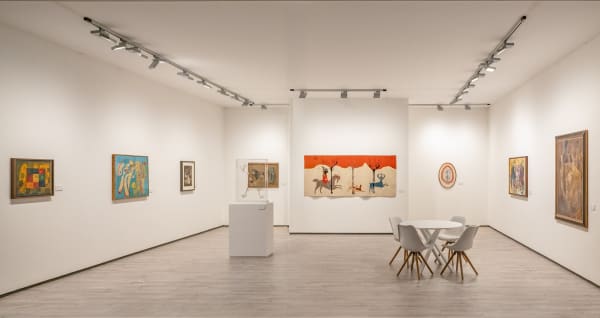
Frieze Masters 2023
Leonora Carrington, Remedios Varo, Alice Rahon, and Wolfgang Paalen October 11 - 15, 2023Between Here and There “Breton Péret Buñuel Leonora Remedios Paalen Alice Gerzso Frida Gironella César Moro convergence of insurgences … There is no outside nor...Read more -

Frieze Masters 2022
Eileen Agar, Leonora Carrington, Remedios Varo, Alice Rahon, Dorothea Tanning October 12 - 16, 2022Gallery Wendi Norris will present 'Phenomena,' a group exhibition featuring fresh-to-market modern works by gallery artists Eileen Agar, Leonora Carrington, Remedios Varo, Alice Rahon, and...Read more -
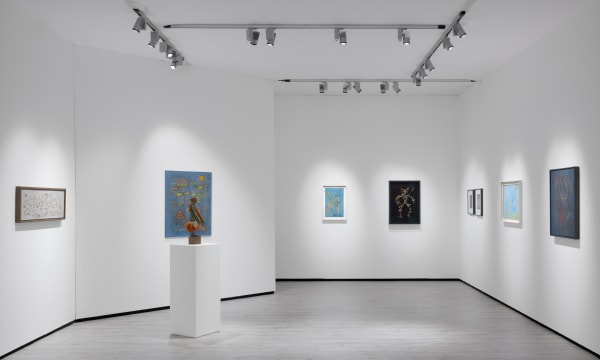
Frieze Masters 2021
Alice Rahon: Unveiling the Immanent October 13 - 17, 2021Asked by a reporter if she belonged to any particular school of painting, Alice Rahon replied, “I think I am a cave painter.” Like her...Read more
-

The New York Times | In London, a California Gallery Shows Expat Mexican Surrealists
For two decades, Gallery Wendi Norris has broadened and complicated ideas about Surrealism. Now she is bringing major Mexican-influenced works to Frieze Masters. October 3, 2025By Will Higginbotham On a Friday morning in July, in the Jackson Square neighborhood of San Francisco, just a stone’s throw from the Transamerica Pyramid,...Read more -

Art Basel | Data, Surrealism, and a little magic: Gallerist Wendi Norris’ recipe for success
Credited with fostering the legacies of artists such as Leonora Carrington and Dorothea Tanning, she will soon showcase her vibrant program at Art Basel Miami Beach for the first time November 14, 2024By Tara Anne Dalbow 14 November, 2024 For San Francisco gallerist Wendi Norris , words matter. More so than ‘surrealist’ – the characteristic most often...Read more -

Frieze | Celebrating 100 Years of Surrealism at Frieze
Discover the movement’s iconic artists and contemporary legacy at the London fairs, from Man Ray, Dora Maar and Leonora Carrington, to Carol Bove and Leiko Ikemura October 3, 2024By Livia Russell 3 October, 2024 '...Leonora Carrington ‘didn’t have time to be anyone’s muse’. Having left London for Paris, with the arrival of World...Read more -

Poetry Reading x Artist Talk
Saturday, September 9, 2023 4 — 6 pm 529 West 20th Street, Ground Floor, New York, NY September 9, 2023On Saturday, September 9, from 4 pm to 6 pm, Gallery Wendi Norris and NYRB Poets will celebrate the opening of Alice Rahon and Ranu...Read more
-

Seven Museums Acquire Work by Gallery Wendi Norris Artists
August 24, 2023Please join Gallery Wendi Norris in congratulating Amon Carter Museum of American Art, Arizona State University Art Museum, Chapman University, Los Angeles County Museum of...Read more -

Artforum | Alice Rahon
January 10, 2023Gabrielle Selz January 10, 2023 Mexican-French artist Alice Rahon (1904–1987) may not be as well-known as Leonora Carrington, Frida Kahlo, and other Surrealists who worked...Read more -

The Art Newspaper | Is Alice Rahon the next Surrealist rediscovery?
August 2, 2022By Jori Finkel August 2, 2022 Nobody has been more instrumental in the recent market reappraisal of women Surrealist artists than San Francisco dealer Wendi...Read more -

Four Museums Acquire Works by Gallery Wendi Norris Artists
July 19, 2022Please join Gallery Wendi Norris in congratulating the Museum of Modern Art, Detroit Institute of Arts, Dallas Museum of Art, and Solomon R. Guggenheim Museum...Read more
-

Four Gallery Wendi Norris Artists Selected for Venice Biennale 2022
February 3, 2022Gallery Wendi Norris celebrates the invitation of four of our artists to The Milk of Dreams , the 59th International Art Exhibition of La Biennale...Read more -

The New York Times | At Frieze London, the Art World Inches Toward Normalcy
The fairs, exhibitions and auctions of “Frieze Week” are in-person events once more. But the art world has changed, and so has Britain. October 15, 2021By Scott Reyburn October 15, 2021 LONDON — It was “business as usual,” said the Russian art adviser and collector Alex Lachmann on Wednesday, as...Read more -

La Jornada | First biography of Alice Rahon published in English
May 6, 2021Merry Macmasters May 6, 2021 The first monograph on the French-Mexican surrealist painter and poet Alice Rahon (1904-1987) has just been published in English. Alice...Read more -

Now online: symposia, curatorial and artist talks
Gallery News April 1, 2021Gallery Wendi Norris is pleased to share our YouTube channel, a video archive of the gallery's symposia, curatorial and artist talks. Here you will find...Read more
-

Uncovering Alice Rahon: a conversation about the artist's first monograph
Event March 24, 2021Wednesday, March 24, 2021 5:00 PM - 6:15 PM PDT Register HERE Like her poetry, Alice Rahon's paintings are thick with mythology and magic, memory...Read more -

The Art Institute of Chicago acquires two major works by Alice Rahon.
Gallery News October 13, 2020Following the recent addition of Alice Rahon (1904-1987) to the program, Gallery Wendi Norris is pleased to announce that the Art Institute of Chicago has...Read more -

Gallery Wendi Norris Now Represents Modern Artist Alice Rahon
Gallery News August 7, 2020SAN FRANCISCO, October 13, 2020. Gallery Wendi Norris is delighted to announce representation of distinguished visual artist and poet Alice Rahon (1904-1987). Rahon worked among...Read more -

ARTnews | Sotheby’s Global Hybrid Online Evening Sale Soars to $363.2 M.
June 30, 2020Angelica Villa June 30, 2020 The art market reopened last night with a resounding bang as Sotheby’s sold $363.2 million in modern and contemporary art...Read more





